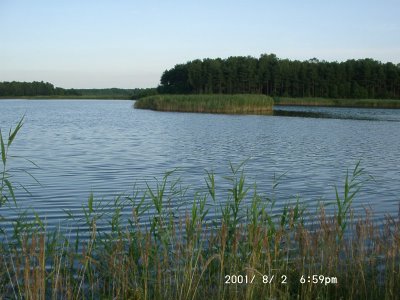Hello:)
Here is an article written by Eric McLamb with special contributions from Dr. Jack C. Hall from
www.ecology.com
I would like to present it today in my blog cause lately I have been interested in trees and their history. If someone has some info about pre-glacier tropical forests in Europe - let me know, please:)
Quiet evolution of trees
Way before trees appeared on Earth, animals and other land plants were scattered among the land masses. And way before land plants came the land animals. How did it all happen, and where did they all come from?
They came from the oceans, where just a few billion years earlier the first animal life evolved followed by plants. So, you see, the occurrence of trees was quite full of twists and turns and came about quietly long after land plants had struggled to rise from the oceans. Yet, their existence is the essence of all life on the planet.
There was a time about 550 million years ago when life "exploded" on the planet. Animal life. Nearly all of the animal groups in existence today -- as well as many that no longer exist -- first appeared on Earth during this time. It was the Cambrian Period, and this time of tumultuous and colossal animal diversity is called the Cambrian Explosion.
Land plants evolved a little more quietly about 90 million years later, with trees evolving some 100 million years after the first land plants began to emerge from their oceanic origins. But neither animals nor plants could have evolved were it not for the protection and nurturing of the ocean.
According to the fossil record -- about 3.5 billion years ago -- the first preserved life are found in the form of bacteria. They appeared in the oceans after the surface (crust) began to cool and stabilize, the land masses began to take shape, and clouds formed to produce massive volumes of rainwater that created the seas. The atmosphere was much different than today and the surface was unprotected from the Sun. This period is known as the Pre-Cambrian, the time that immediately followed the formative, molten and gaseous stage of Earth as it and the rest of the solar system started to come together -- or coalesce.
The first plants on Earth were a form of blue-green algae which appeared and lived in the oceans about 3.4 billion years ago according to the fossil record, protected from the harmful high energy radiation of the Sun. In the oceans, these plants were able to grow and photosynthesize as this high energy radiation was absorbed by the water. Now, to be perfectly clear about it, the first true algae (the kingdom protoctista) most likely made their first appearance about 2.4 billion years ago, but for sure by 1.8 billion years ago as the first acritarchs.
Although animals were the first life forms on Earth, it was plants that paved the way for land animals to evolve. Plants did this by simultaneously increasing the percentage of oxygen in the Earth's atmosphere and decreasing the percentage of carbon dioxide, a powerful greenhouse gas (Journal Science, August 2001).
Still, if you were to travel back about some 470 million years ago, Earth would seem lifeless, inhospitable and very barren. For one thing, no trees -- no plants at all -- lived on the land !
The first land plants made their appearance way before trees started driving their roots into the hard crust of Earth's surface, about 460 million years ago in the Ordovician period. Algae were the first land plants, moving from their aquatic origins to marshy and wet environments on land. It took consistent growth and diversification of land plants -- including the eventual evolution of trees -- to help break up the mostly iron-clad surface of the Earth.
Rising Out of the Ocean
To move from the water to land, plants had to adapt systems that would support their weight, provide transport of water and nutrients throughout their system, protect them from drying out, and insulate them from the sun and temperature changes. Obviously, if these adaptations were not difficult, plants would have moved on to land much earlier in the geological history of the Earth. Instead, they appear rather late in the history of life on this planet.
Trees first appeared and began to cover the land surface of the Earth some 370 million years ago. Today, we are so used to and dependent on trees that it's hard to believe that animals could have existed without them or that they did not at least simultaneously evolve together in the beginning.
Trees, with their large and thick roots, helped break up the rocky crust of Earth's surface to create the soil that would allow the development of new plant species, including other trees. And it was the greater evolution of plants and trees that enabled the evolution of larger and more diverse land animals, including mammals. (Keep in mind that the first land animals - bugs - were plant eaters, and they required more and diverse vegetation to evolve.)
But what was the first tree? And what made it a tree?
The First Tree...and Forests
First of all, it's important to understand that what makes trees unique from all other plants is they all have wood. Wood is a much tougher, thicker and reinforced fiber necessary for trees to hold themselves up under the pressure of their weight. As plants began to evolve and diversify, this fortification was necessary in order for them to branch out into much larger and heavier plants. As such, the evolution of wood is synonymous with the evolution of trees.
The earliest known modern tree is the Archaeopteris, a tree that looked similar to a Christmas tree with buds, reinforced branch joints and wood similar to today's timber. Its branches and leaves resembled a fern.
When the archaeopteris tree first appeared 370 million years ago, it quickly covered most parts of the Earth with its first forests and was the dominant tree wherever the planet was habitable. During this time, most of Earth's land masses were assembled south of the equator as part of the supercontinent Pangaea, which eventually split into the even continents that exist today. Can you imagine Antarctica being covered with forests! Over the past 370 million years, countless new tree species have evolved and eventually became extinct - like the archaeopteris - as the Earth's land masses moved about, climates changed, animal populations increased, and, of course, new species of plants evolved to take the place of the extinct ones.
Trees Today
Today there are approximately 100,000 known species of trees that exist throughout the world, according to World Resources Institute. A recent report from the United Nations Environment Program World Monitoring Center confirms that over 8,000 species are threatened with extinction and 976 of those are in a critical state.
(While it is important to note that these figures are not necessarily precise, they are the result of careful and comprehensive monitoring by field scientists worldwide. In as much the same way that it is currently impossible for us to know exactly how many animal species exist and have even died out without being discovered, it is also impossible to know exactly how many tree species currently exist or have existed on this planet.)
The Quiet Truth about Trees
Trees are vitally important to world health on all levels. Globally, forests are essential to the health of ecosystems and their functions, biodiversity and economics. Some of the many key functions of forests include climate regulation, the cycling and distribution of nutrients, and the provision of raw materials and resources. Trees cleanse the air and provide oxygen, help soil retain water, shield animals and other plants from the sun and other elements, and provide habitat for animals and plants. They help regulate the climate, cycle and distribute nutrients and provide raw materials and other resources. And don't forget the awesome beauty they give us throughout each year!
Several economic estimates -- including a report by Mark Baird, Indonesia Country Director for World Bank -- state that forests provide approximately US$1,000.00 per hectare -- or about $4 trillion -- in goods and services annually (Source: Forest Crime as a Constraint on Development, 9/13/2001). However, Mr. Baird points out that this figure "does not account for lost biodiversity for which there [is] no agreed estimating methodology."
Moreover, just one-fifth of the world's original forest cover remains in large, contiguous areas of relatively undisturbed forest. These forests are called frontier forests, the largest of which exists in Russia.
But before we start blaming human greed, there is an important principle about ecology and how all species depend on other flora and fauna in order to evolve, grow and become healthy. For this to happen, some species must pass on in order that new species can live and evolve.
Take the dinosaurs for instance. They died out some 65 million years ago -- along with 70% of the total species on Earth at that time -- which made room for the evolution of new species. Humans came along towards the end of this new evolutionary chain effect. Not to oversimplify the matter, but technically, if the dinosaurs had not died out, humans may not have evolved.
"It's All About Tradeoffs..."
Likewise, would humans have been able to make progress and perpetuate their species if forests continued to dominate Earth's land areas? It is the enormous growth of the human species and the increasing needs and demands of the human population that have become critical factors in the forest cover equation and the perpetuation of many tree species today.
"It's all about tradeoffs," says Emily Matthews, senior associate for World Resources Institute in Washington, DC. "The whole sustainability world is thinking about tradeoffs. What are we humans prepared to give up in order to have something else and still maintain the environmental goods and services we need?"
More of the natural environment will inevitably be lost, Ms. Matthews explains. "But, do we have to ruin so much, which is pretty much the way we are headed now? The question is, 'Can we be smarter about development in the future?'"
Indeed!
The process of natural selection for trees continues, but the advent of the Industrial Revolution created the foundation for exorbitant human demands of the land inhabited by trees. With the vast improvements in human health and technology, the human population would grow at a rate unparalleled by any other major land animal species in Earth's 4.5 billion year history. And this would mean the demands for more resources from the Earth would increase exponentially. And so, humans have cleared forests primarily for their resources, to build cities and housing, and for agriculture. Industrialization has also been a significant contributor to the loss of our forest cover. When you consider that the world population has grown by more five billion people since the beginning of the Industrial Revolution, you can just imagine how much the world's forests have been counted on to meet human needs!
According to United Nations estimates, approximately one billion people lived on the planet by 1800 -- the early years of the Industrial Revolution. The population would rise to about 1.7 billion by 1900 and to 2.5 billion by 1950. Then the human population exploded! Over a period of 50 years, the population would increase 2.5 times to roughly 6.3 billion people today.
From 1990 - 2000, about two percent of the world's forest cover - roughly 10 million hectares - was lost and not recovered, according the Food and Agriculture Organization (FAO). That rate continues today. As it is today, the forests were mostly converted for agriculture, housing and city expansion (see urban sprawl) to meet the growing demands of the growing population. And therein lies the key to our dilemma!
Dynamics of Deforestation
The fact is, forests are being cut down and not replaced at a high rate in developing countries where their human populations are growing and their healthy development requires more use of land for agriculture, housing and roads, according to World Resources Institute's Ms. Mathews.
"In the developing countries, even with replanting, there is a big net loss," says Ms. Matthews. "Why? Their population is growing fast, they are building their economy and growing food to support themselves. Some developing countries are also major producers and exporters of timber for industrial use."
In developed countries, however, forest cover is "fairly stable," according to Ms. Matthews, "but there is still a certain amount of depletion of natural forests."
"In other words, developed countries' populations have somewhat stabilized, but they are still showing a certain aggressive appetite for clearing trees. The difference is they are in most cases replanting at least what they reap." But Ms. Matthews is quick to point out that new planting is not equivalent to old forests and cannot replace their value.
China is one exception for a developing nation. China showed a 1.2% annual increase of its forest area from 1990-2000 (FAO Forest Resource Assessment 2000) due to tree replanting.
The Key
Certainly, stabilization of human population growth and wise use of resources are key to a majority of today's ecological, public health and economical challenges. As the human population grows, sustainable development appears not only logical, but essential.
According to American Forests, healthy cities should have an average tree canopy coverage of forty percent to ensure their ecological, economic and social sustainability. Rural areas should set a goal of at least fifty percent. But for many nations, the demand for resources from the forests are giving way to expansion and massive deforestation.
Still, says Deborah Gangloff, executive director for American Forests, the human population growth has helped us realize the importance of trees. "Understanding the changes we've made on the landscape helps us understand how we can take steps to revitalize it," said Ms. Gangloff. "We do know that planting trees is one of the most cost-effective ways to capitalize on the natural services provided by healthy ecosystems."
If the 'sustainability world' is smart about it, our forests will continue to evolve...quietly, and function, quietly, as guardians and vital instruments of Earth's ecosystems.
Yet -- and unthinkably, if the last tree on Earth falls, it will fall quietly in much the same way the first tree evolved and once covered the planet.
Did You Know...?
| 1. Today, there are only three great forests left on Earth: the Amazon Forest of Brazil, and the boreal forests in Russia and Canada. |
| 2. Forests contain between 50-90% of terrestrial (land-living) species. Tropical forests alone are thought to contain between 10-50 million species - over 50% of species on the planet. (Source: Environmental Investigation Agency) |
| 3. Rainforests cover two percent of the Earth's surface and six percent of its land mass. Yet they are home to over half of the world's plant and animal species. Originally, rainforest covered twice the area they do today. (Source: Rainforest Action Network) |
| 4. There are approximately 1.6 acres (.65 hectares) of forests per person living on the planet. (Source: Food and Agriculture Organization, Forest resources Assessment 2000) |
| 5. Forests provide a staggering range of products, with some 15,000 species of wild plants and animals are used for foods, medicines and other functions. (Source: Environmental Investigation Agency) |
| 6. All of Earth's oxygen is produced by photosynthesis, the process plants use to combine water and carbon dioxide to create glucose (their own food) and oxygen. |
| 7. The first dinosaurs on Earth appeared only about 140 million years after trees first appeared÷ about 230 million years ago. |
| 8. Just three trees planted around the average size home can lower air-conditioning bills by up to 50%, and trees that shield homes against the wind can lower heating bills by up to 30%. |
| 9. Trees produce natural anti-freeze chemicals which can keep them from freezing in temperatures up to -40 degrees Fahrenheit in some species. |
| 10. Technically, deforestation only occurs when land once covered with trees is totally converted to other use and is not replanted. |
| 11. An average tree absorbs ten pounds of pollutants from the air each year, including four pounds of ozone and three pounds of particulates. (Source: Friends of Trees) |
Thank you for your attention!:)


 Thank you China:)
Thank you China:)







































